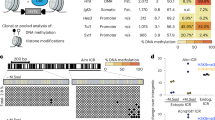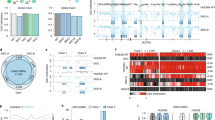Abstract
The epigenetic regulation of imprinted genes by monoallelic DNA methylation of either maternal or paternal alleles is critical for embryonic growth and development1. Imprinted genes were recently shown to be expressed in mammalian adult stem cells to support self-renewal of neural and lung stem cells2,3,4; however, a role for imprinting per se in adult stem cells remains elusive. Here we show upregulation of growth-restricting imprinted genes, including in the H19–Igf2 locus5, in long-term haematopoietic stem cells and their downregulation upon haematopoietic stem cell activation and proliferation. A differentially methylated region upstream of H19 (H19-DMR), serving as the imprinting control region, determines the reciprocal expression of H19 from the maternal allele and Igf2 from the paternal allele1. In addition, H19 serves as a source of miR-675, which restricts Igf1r expression6. We demonstrate that conditional deletion of the maternal but not the paternal H19-DMR reduces adult haematopoietic stem cell quiescence, a state required for long-term maintenance of haematopoietic stem cells, and compromises haematopoietic stem cell function. Maternal-specific H19-DMR deletion results in activation of the Igf2–Igfr1 pathway, as shown by the translocation of phosphorylated FoxO3 (an inactive form) from nucleus to cytoplasm and the release of FoxO3-mediated cell cycle arrest, thus leading to increased activation, proliferation and eventual exhaustion of haematopoietic stem cells. Mechanistically, maternal-specific H19-DMR deletion leads to Igf2 upregulation and increased translation of Igf1r, which is normally suppressed by H19-derived miR-675. Similarly, genetic inactivation of Igf1r partly rescues the H19-DMR deletion phenotype. Our work establishes a new role for this unique form of epigenetic control at the H19–Igf2 locus in maintaining adult stem cells.
This is a preview of subscription content, access via your institution
Access options
Subscribe to this journal
Receive 51 print issues and online access
$199.00 per year
only $3.90 per issue
Buy this article
- Purchase on Springer Link
- Instant access to full article PDF
Prices may be subject to local taxes which are calculated during checkout




Similar content being viewed by others
Accession codes
Accessions
ArrayExpress
Data deposits
The microarray and RNA-seq data have been deposited in ArrayExpress under accession numbers E-MTAB-1644 and E-MTAB-1628, respectively.
References
Bartolomei, M. S. Genomic imprinting: employing and avoiding epigenetic processes. Genes Dev. 23, 2124–2133 (2009)
Berg, J. S. et al. Imprinted genes that regulate early mammalian growth are coexpressed in somatic stem cells. PLoS ONE 6, e26410 (2011)
Ferrón, S. R. et al. Postnatal loss of Dlk1 imprinting in stem cells and niche astrocytes regulates neurogenesis. Nature 475, 381–385 (2011)
Zacharek, S. J. et al. Lung stem cell self-renewal relies on BMI1-dependent control of expression at imprinted loci. Cell Stem Cell 9, 272–281 (2011)
DeChiara, T. M., Robertson, E. J. & Efstratiadis, A. Parental imprinting of the mouse insulin-like growth factor II gene. Cell 64, 849–859 (1991)
Keniry, A. et al. The H19 lincRNA is a developmental reservoir of miR-675 that suppresses growth and Igf1r. Nature Cell Biol. 14, 659–665 (2012)
Haug, J. S. et al. N-cadherin expression level distinguishes reserved versus primed states of hematopoietic stem cells. Cell Stem Cell 2, 367–379 (2008)
Yang, L. et al. Identification of Lin−Sca1+kit+CD34+Flt3- short-term hematopoietic stem cells capable of rapidly reconstituting and rescuing myeloablated transplant recipients. Blood 105, 2717–2723 (2005)
Frost, J. M. & Moore, G. E. The importance of imprinting in the human placenta. PLoS Genet. 6, e1001015 (2010)
Hudson, Q. J., Kulinski, T. M., Huetter, S. P. & Barlow, D. P. Genomic imprinting mechanisms in embryonic and extraembryonic mouse tissues. Heredity 105, 45–56 (2010)
Thorvaldsen, J. L., Fedoriw, A. M., Nguyen, S. & Bartolomei, M. S. Developmental profile of H19 differentially methylated domain (DMD) deletion alleles reveals multiple roles of the DMD in regulating allelic expression and DNA methylation at the imprinted H19/Igf2 locus. Mol. Cell. Biol. 26, 1245–1258 (2006)
Lerner, C. & Harrison, D. E. 5-Fluorouracil spares hemopoietic stem cells responsible for long-term repopulation. Exp. Hematol. 18, 114–118 (1990)
Smith, F. M., Garfield, A. S. & Ward, A. Regulation of growth and metabolism by imprinted genes. Cytogenet. Genome Res. 113, 279–291 (2006)
Kang, H. M., Park, S. & Kim, H. Insulin-like growth factor 2 enhances insulinogenic differentiation of human eyelid adipose stem cells via the insulin receptor. Cell Prolif. 44, 254–263 (2011)
Zhang, J. et al. PTEN maintains haematopoietic stem cells and acts in lineage choice and leukaemia prevention. Nature 441, 518–522 (2006)
Tothova, Z. et al. FoxOs are critical mediators of hematopoietic stem cell resistance to physiologic oxidative stress. Cell 128, 325–339 (2007)
Klinakis, A. et al. Igf1r as a therapeutic target in a mouse model of basal-like breast cancer. Proc. Natl Acad. Sci. USA 106, 2359–2364 (2009)
Zou, P. et al. p57(Kip2) and p27(Kip1) cooperate to maintain hematopoietic stem cell quiescence through interactions with Hsc70. Cell Stem Cell 9, 247–261 (2011)
Walkley, C. R., Shea, J. M., Sims, N. A., Purton, L. E. & Orkin, S. H. Rb regulates interactions between hematopoietic stem cells and their bone marrow microenvironment. Cell 129, 1081–1095 (2007)
Kubota, Y., Osawa, M., Jakt, L. M., Yoshikawa, K. & Nishikawa, S. Necdin restricts proliferation of hematopoietic stem cells during hematopoietic regeneration. Blood 114, 4383–4392 (2009)
Stadtfeld, M. et al. Aberrant silencing of imprinted genes on chromosome 12qF1 in mouse induced pluripotent stem cells. Nature 465, 175–181 (2010)
Zhao, Z. et al. Circular chromosome conformation capture (4C) uncovers extensive networks of epigenetically regulated intra- and interchromosomal interactions. Nature Genet. 38, 1341–1347 (2006)
Varrault, A. et al. Zac1 regulates an imprinted gene network critically involved in the control of embryonic growth. Dev. Cell 11, 711–722 (2006)
Karlsson, G. et al. Smad4 is critical for self-renewal of hematopoietic stem cells. J. Exp. Med. 204, 467–474 (2007)
Sugimura, R. et al. Noncanonical wnt signaling maintains hematopoietic stem cells in the niche. Cell 150, 351–365 (2012)
Perry, J. M. et al. Cooperation between both Wnt/β-catenin and PTEN/PI3K/Akt signaling promotes primitive hematopoietic stem cell self-renewal and expansion. Genes Dev. 25, 1928–1942 (2011)
Dijke, P. & Heldin, C. H. Smad Signal Transduction: Smads in Proliferation, Differentiation and Disease (Springer, 2006)
Johnson, C. D. et al. The let-7 microRNA represses cell proliferation pathways in human cells. Cancer Res. 67, 7713–7722 (2007)
Toledano, H., D’Alterio, C., Czech, B., Levine, E. & Jones, D. L. The let-7-Imp axis regulates ageing of the Drosophila testis stem-cell niche. Nature 485, 605–610 (2012)
Yu, W. et al. A novel amplification target, DUSP26, promotes anaplastic thyroid cancer cell growth by inhibiting p38 MAPK activity. Oncogene 26, 1178–1187 (2007)
Thorvaldsen, J. L., Fedoriw, A. M., Nguyen, S. & Bartolomei, M. S. Developmental profile of H19 differentially methylated domain (DMD) deletion alleles reveals multiple roles of the DMD in regulating allelic expression and DNA methylation at the imprinted H19/Igf2 locus. Mol. Cell. Biol. 26, 1245–1258 (2006)
Dietrich, P., Dragatsis, I., Xuan, S., Zeitlin, S. & Efstratiadis, A. Conditional mutagenesis in mice with heat shock promoter-driven cre transgenes. Mamm. Genome 11, 196–205 (2000)
Zhang, J. et al. Identification of the haematopoietic stem cell niche and control of the niche size. Nature 425, 836–841 (2003)
Haug, J. S. et al. N-cadherin expression level distinguishes reserved versus primed states of hematopoietic stem cells. Cell Stem Cell 2, 367–379 (2008)
Miller, C. L. & Eaves, C. J. Expansion in vitro of adult murine hematopoietic stem cells with transplantable lympho-myeloid reconstituting ability. Proc. Natl Acad. Sci. USA 94, 13648–13653 (1997)
Akashi, K. et al. Transcriptional accessibility for genes of multiple tissues and hematopoietic lineages is hierarchically controlled during early hematopoiesis. Blood 101, 383–389 (2003)
Bolstad, B. M., Irizarry, R. A., Astrand, M. & Speed, T. P. A comparison of normalization methods for high density oligonucleotide array data based on variance and bias. Bioinformatics 19, 185–193 (2003)
Irizarry, R. A. et al. Exploration, normalization, and summaries of high density oligonucleotide array probe level data. Biostatistics 4, 249–264 (2003)
Irizarry, R. A. et al. Summaries of Affymetrix GeneChip probe level data. Nucleic Acids Res. 31, e15 (2003)
Smyth, G. K. Linear models and empirical bayes methods for assessing differential expression in microarray experiments. Stat. Appl. Genet. Mol. Biol. 3, Article3 (2004)
Ema, H. et al. Adult mouse hematopoietic stem cells: purification and single-cell assays. Nature Protocols 1, 2979–2987 (2006)
Trapnell, C., Pachter, L. & Salzberg, S. L. TopHat: discovering splice junctions with RNA-Seq. Bioinformatics 25, 1105–1111 (2009)
Langmead, B., Trapnell, C., Pop, M. & Salzberg, S. L. Ultrafast and memory-efficient alignment of short DNA sequences to the human genome. Genome Biol. 10, R25 (2009)
Trapnell, C. et al. Transcript assembly and quantification by RNA-Seq reveals unannotated transcripts and isoform switching during cell differentiation. Nature Biotechnol. 28, 511–515 (2010)
Acknowledgements
We thank M. Hembree, T. Johnson, H. Marshall, B. Lewis, D. Dukes, C. Semerad, J. Park and A. Box for technical support, and members of the Li laboratory for scientific discussion. We thank J. Lu and Y. Huang for communications about miR-675 and Let-7. We thank K. Tannen for editing. This work was supported by the Stowers Institute for Medical Research and by the Department of Biotechnology, Ministry of Science and Technology, Government of India, as an overseas associateship to A. Venkatraman. M. Bartolomei is supported by the National Institutes of Health (GM51279).
Author information
Authors and Affiliations
Contributions
A.V. performed experiments, analysed data and wrote the manuscript. X.H. provided training, performed transplantations and RNA-seq. F.T., J.T., M.C., L.P., X.Z., A.P., H.L., J.P. M.Z., J.H. and T.C. performed part of the experiments. M.B. contributed the mouse lines. L.L. directed the overall project and co-wrote the manuscript. All authors contributed to reading and editing the manuscript.
Corresponding author
Ethics declarations
Competing interests
The authors declare no competing financial interests.
Supplementary information
Supplementary Figures
This file contains Supplementary Figures 1-7. (PDF 869 kb)
Rights and permissions
About this article
Cite this article
Venkatraman, A., He, X., Thorvaldsen, J. et al. Maternal imprinting at the H19–Igf2 locus maintains adult haematopoietic stem cell quiescence. Nature 500, 345–349 (2013). https://doi.org/10.1038/nature12303
Received:
Accepted:
Published:
Issue Date:
DOI: https://doi.org/10.1038/nature12303
This article is cited by
-
Functions and regulatory mechanisms of resting hematopoietic stem cells: a promising targeted therapeutic strategy
Stem Cell Research & Therapy (2023)
-
Platelet and myeloid lineage biases of transplanted single perinatal mouse hematopoietic stem cells
Cell Research (2023)
-
Cell-intrinsic factors governing quiescence vis-à-vis activation of adult hematopoietic stem cells
Molecular and Cellular Biochemistry (2023)
-
Inhibition of the epigenetically activated miR-483-5p/IGF-2 pathway results in rapid loss of meningioma tumor cell viability
Journal of Neuro-Oncology (2023)
-
Long noncoding RNAs as regulators of pediatric acute myeloid leukemia
Molecular and Cellular Pediatrics (2022)
Comments
By submitting a comment you agree to abide by our Terms and Community Guidelines. If you find something abusive or that does not comply with our terms or guidelines please flag it as inappropriate.



